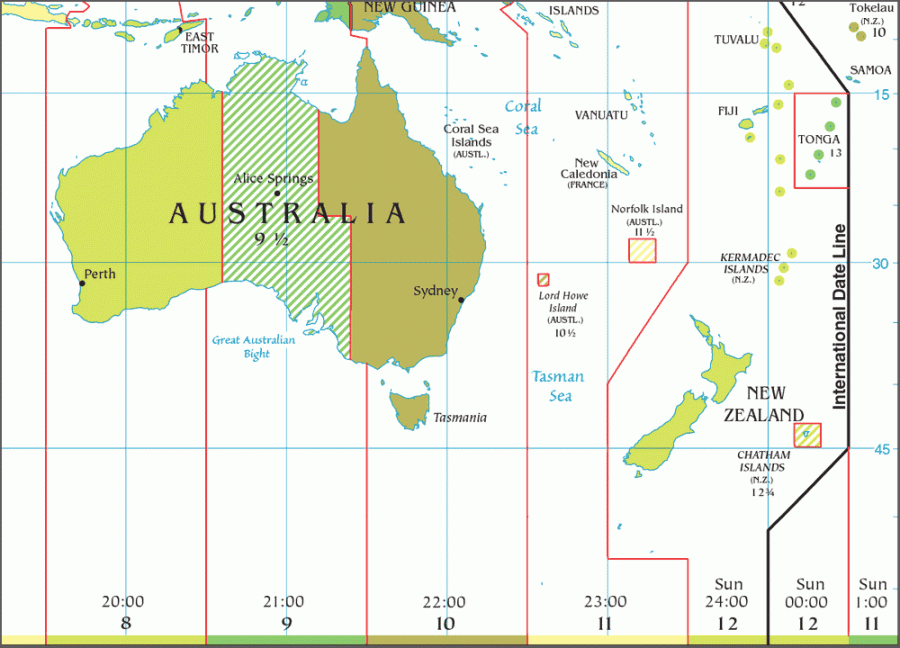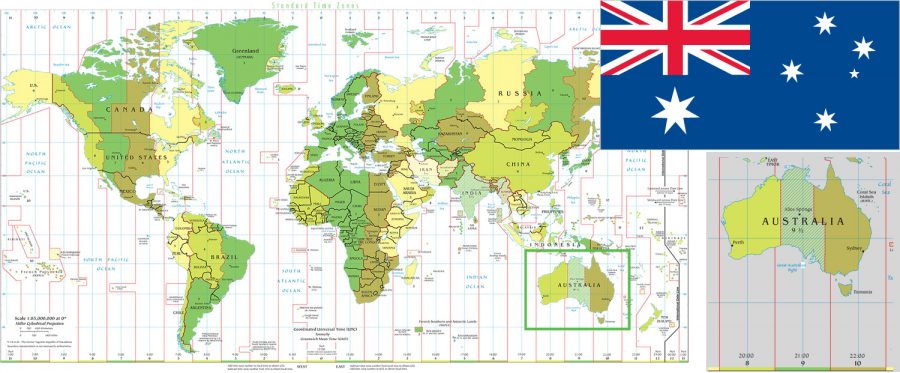Back to main page AUSTRALIA


With a land mass close to 7.7 million square kilometres, Australia is the world’s sixth largest country and is divided into three separate time zones.
- Australian Eastern Standard Time (AEST)
- Australian Central Standard Time (ACST)
- Australian Western Standard Time (AWST)
AEST is equal to Coordinated Universal Time plus 10 hours (UTC +10).
ACST is equal to Coordinated Universal Time plus 9.5 hours (UTC +9.5).
AWST is equal to Coordinated Universal Time plus 8 hours (UTC +8).
Time zones
| Time zone | State or territory | City | UTC relative |
|---|---|---|---|
| Australian Eastern Standard Time (AEST) | Queensland, New South Wales (except Broken Hill), Victoria, Tasmania, Australian Capital Territory | Brisbane, Sydney, Melbourne, Hobart, Canberra | UTC+10:00 |
| Australian Central Standard Time (ACST) | South Australia, Northern Territory and the town of Broken Hill in western New South Wales | Adelaide, Darwin, Broken Hill | UTC+09:30 |
| Australian Western Standard Time (AWST) | Western Australia | Perth | UTC+08:00 |
| Norfolk Island Standard Time (NFT) | Norfolk Island | Kingston | UTC+11:00 |
| Christmas Island Standard Time (CXT) | Christmas Island | UTC+07:00 | |
| Cocos (Keeling) Islands Standard Time (CCT) | Cocos (Keeling) Islands | UTC+06:30 |
Daylight saving
Daylight Saving Time (DST) is the practice of advancing clocks one hour during the warmer months of the year. In Australia, Daylight saving is observed in New South Wales, Victoria, South Australia, Tasmania, and the Australian Capital Territory.
Daylight saving is not observed in Queensland, the Northern Territory or Western Australia.
Daylight Saving Time begins at 2am on the first Sunday in October, when clocks are put forward one hour. It ends at 2am (which is 3am Daylight Saving Time) on the first Sunday in April, when clocks are put back one hour.
Find the current DST dates on our website in the right sidebar !
During Daylight Saving Time (first Sunday in October – first Sunday in April)
| Time zone | State or territory | City | UTC relative |
|---|---|---|---|
| Australian Eastern Standard Time (AEST) | Queensland | Brisbane | UTC+10:00 |
| Australian Eastern Daylight Time (AEDT) | New South Wales (except Broken Hill), Victoria, Tasmania, Australian Capital Territory | Sydney, Melbourne, Hobart, Canberra | UTC+11:00 |
| Australian Central Daylight Time (ACDT) | South Australia and the town of Broken Hill in western New South Wales | Adelaide, Broken Hill | UTC+10:30 |
| Australian Central Standard Time (ACST) | Northern Territory | Darwin | UTC+09:30 |
| Australian Western Standard Time (AWST) | Western Australia | Perth | UTC+08:00 |
| Norfolk Island Daylight Time (NFDT) | Norfolk Island | Kingston | UTC+12:00 |
| Christmas Island Standard Time (CXT) | Christmas Island | UTC+07:00 | |
| Cocos (Keeling) Islands Standard Time (CCT) | Cocos (Keeling) Islands | UTC+06:30 |
Daylight saving is not observed in Queensland, the Northern Territory, Western Australia, Christmas Island or the Cocos (Keeling) Islands.
(updated: 3-Oct-2019, Source: Source: Australian Government (australia.gov.au); CC Attribution 3.0 Australia (CC BY 3.0 AU) )

